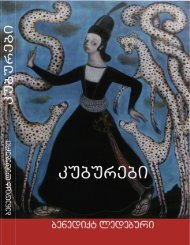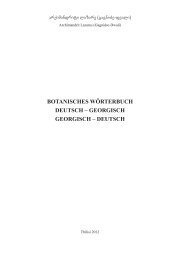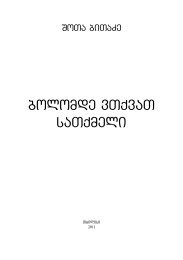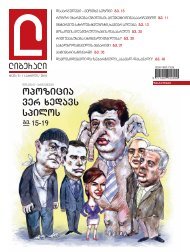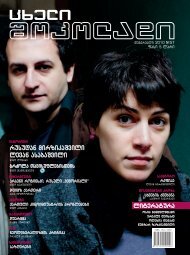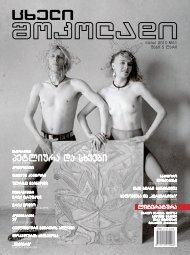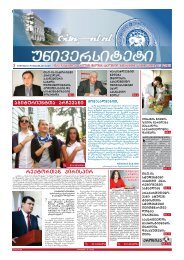Untitled - Iverieli
Untitled - Iverieli
Untitled - Iverieli
You also want an ePaper? Increase the reach of your titles
YUMPU automatically turns print PDFs into web optimized ePapers that Google loves.
Chorokhi basin lands and Samtskhe – in the Mtkvari basin territories. This<br />
edition makes biased and separatist transformation of the Eptvime’s<br />
translation of the Journeys. St Andrew’s preaching and his ordination of the<br />
first Georgian bishop is connected to Atskuri – the ecclesiastical center of<br />
Samtskhe-Saatabago. It emphasizes the «Apostolic» nature of Meskhian<br />
Church striving for independence.<br />
The period of Samdzivari glory (12 th -15 th centuries) should separately<br />
be singled out in the development of the Meskhian tradition. Its first literary<br />
version is confirmed in Manuel the Rhetorician’s Greek work Narrations on<br />
the Atskuri Icon and Miracles written in 1501-1504 by the order of Ioakim<br />
I, Patriarch of Constantinople (1498-1502, 1504). Manuel’s Narrations<br />
represents a vast chronicle of the Atskuri icon and consists of four main<br />
parts: a) Meskhian tradition on St Andrew’s preaching in Achara and<br />
Samtskhe; b) Chronicle from the times of Emperor Heracles (Irakli); c)<br />
Icon’s captivity by Uzun-Hassan (1477); d) Icon’s captivity by Sultan<br />
Yakub.<br />
The Georgian version of the Atskuri icon chronicle took its full and<br />
completed form in 1546-1562. Later it was separated into fragments and in<br />
1760s were included as interludes in the corresponding sections of the<br />
Akhali Kartlis Tskhovreba (Revised History of Georgia): a) Meskhian<br />
tradition – into the King Aderki’s Chronicle; b) Chronicle from the times of<br />
Emperor Heracles – into The Life of Vakhtang Gorgasali; c) the miracles of<br />
the icon’s captivities by Uzun-Hassan and Sultan Yakub (together with<br />
short chronicles of 1546 and 1553) – into the Revised History of Georgia<br />
proper.<br />
Earlier, in 1501-1516 the edition of the Meskhian tradition by<br />
Mzechabuki was created which included the episodes of the participation of<br />
the Holy Virgin in the Apostles’ casting the lot. The first illustration of the<br />
Meskhian tradition is the fresco at Gelati Virgin’s cathedral (second half of<br />
the 17 th century) which depicts St Andrew with the Atskuri icon in his hand.<br />
The issue of Sosangeti localization gained a special actuality in the<br />
Georgian literary sources. Initially it was identified with Nigali (monk<br />
Arsen), later – with Svaneti and Sivneti (Georgian edition of the Journeys),<br />
and finally – with Atskuri (Meskhian tradition).<br />
The literary version of the Meskhian tradition and the Georgian edition<br />
of the Journeys are included in Revised History of Georgia with slight<br />
changes in the form of three vast inclusions:<br />
1) The first inclusion is based on the Meskhian tradition and tells about<br />
155<br />
the apostles’ casting the lot, Holy Virgin’s lot, depiction of the Virgin’s icon<br />
and sending of St Andrew to Georgia;<br />
2) The second inclusion follows (in some lists – replaces) Leonti<br />
Mroveli’s words: «He converted the Megrelians and went on towards<br />
Klarjeti». It depicts St Andrew’s first missionary journey (according to the<br />
first Georgian edition of the Journeys) and the Meskhian tradition about St<br />
Andrew’s preaching in Didachara and Atskuri (this part of the inclusion<br />
directly follows the medium phrase «which is called Didadjara»);<br />
3) The third inclusion depicts the third missionary journey of St<br />
Apostle Andrew according to the Georgian edition of the Journeys.<br />
The episode from St Andrew’s second journey in replaced in the<br />
Revised History of Georgia by the authentic information from Leonti<br />
Mroveli about the Megrelians’ conversion to Christianity and their forceful<br />
re-paganism by king Aderk.<br />
The Urbnisi list of the Kartlis Tskhovreba preserved a different version<br />
of the Journeys. It avoids the apostle’s preaching in Meskheti but in return<br />
expands the section dedicated to Kartli.<br />
The tendency confirmed in the Urbnisi edition was developed by<br />
Teimuraz Batonishvili (Prince Teimuraz Bagrationi) who further specified<br />
the route of St Andrew’s preaching in his book History of Iveria and<br />
included into it Mtskheta, Gremi and Stepantsminda (Kazbegi). Apart from<br />
this, he completely changed the geography of the Meskhian tradition and<br />
granted Atskuri’s role to Bichvinta.<br />
At different times the deposition of five sacred icons were connected to<br />
the name of St Andrew in Georgia. These are the following: (1) Icon of<br />
Anchi Saviour (Chants of Anchi Icon); (2) Atskuri Virgin with two copies –<br />
(3) Didadjara and (4) Shatberdi icons (Meskhian tradition); (5) Bichvinta<br />
Virgin’s Icon (History of Iveria).<br />
156



